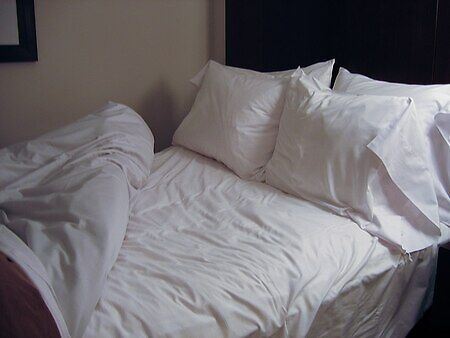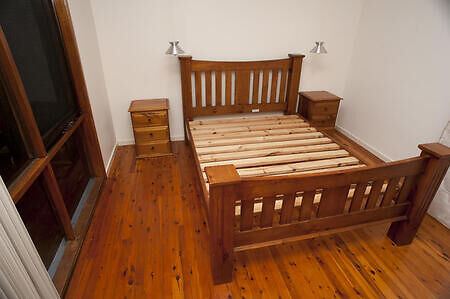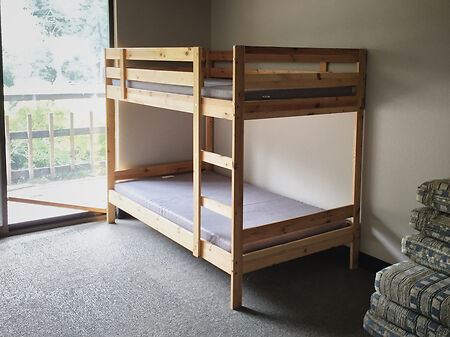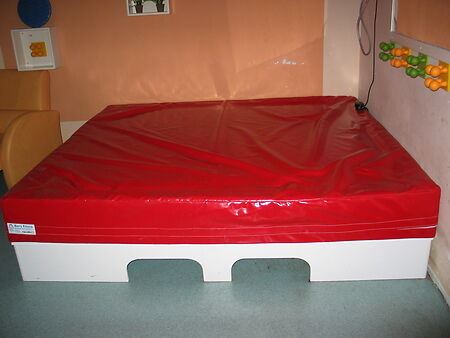If you are relocating to a new place, you'll need to learn how to properly pack your mattresses and beds for the move. From bunk beds to waterbeds, and from king size mattresses to twin size, we've got all the tips you need to help make your move easy and organized.
How to Pack Bedding for Moving

Before packing a mattress and bed, you'll need to pack bedding, which includes items like blankets, sheets, pillows, and comforters.
List of Packing Supplies You'll Need
Here are some packing supplies you'll need when packing bedding and mattresses:
- Medium or large boxes
- Mattress carton or mattress bags for moving
- Stack of packing paper
- A roll of packing tape
- A permanent marker
The Best Way to Pack Bedding When Moving:
- Prepare the box by lining its bottom and sides with packing paper. There is no need to create extra cushioning for your bedding as doing so will just take up valuable space. All you need is a single layer on the bottom to prevent the items from getting soiled during the move.
- Place the heaviest and largest items like comforters and quilts on the bottom of the box.
Note: As you put each item in the box, press down on it to remove air. This will compress the bedding and allow you to fit more into each box.
- Continue to fill each box with your remaining pillows, blankets, sheets, and towels.
- When you have filled a box, put an additional sheet of packing paper on top.
- Close the flaps and seal the box shut with tape.
- Finally, label the box with the contents and destination.
How to Pack and Move Your Mattress
After you have removed the bedding and packed it in a box, it's time to pack the mattress and box spring. Whether it's a king-size mattress, a queen size, a full, or a twin-sized, the method of packing and moving mattresses is the same.
Packing Your Mattress for Moving
Here are some steps on how to pack your mattress for moving:
- Using a mattress carton (box)- If you are using a mattress carton, start by assembling it to get it ready for packing the mattress. Stand the carton on its narrow side such that its opening is facing you, lift the mattress up (It is best with the help of a friend), and put it inside the carton.
- Using a mattress bag- Find a mattress bag for moving that fits the size of your mattress and the box spring either from a moving company or from a store that sells packing supplies.
- Make sure that the mattress doesn't touch the floor as you place it inside the carton/bag as it might damage the mattress.
- Next secure the carton/bag with tape and label it appropriately. Apply the same method for all other mattresses you have at home.
- While moving the mattress onto the truck, stand it on its side and load it onto the truck with the help of a friend.
- If the mattress contains memory foam, load it flat in the vehicle as moving it sideways may shift the foam-filled inside the mattress.
 How to Pack and Move Your Bed Frame
How to Pack and Move Your Bed Frame
Once the bedding and mattress are securely packed, it's time to disassemble the bed frame. Here's how to take apart the bed frame:
- Gather all the tools to unscrew the footboard and headboard from the bed frame. Remove the headboard and footboard by unscrewing them from the bed frame. Make sure to keep track of the screws so you can easily reassemble them when the time comes.
Tip: Place all screws and small pieces in a marked plastic bag, label it appropriately, and tape it to the bed using packing tape. This way, the parts will not be lost or misplaced during the move.
- Wrap the headboard and footboard with moving blankets. Moving blankets or moving pads will help to secure the headboard and footboard from any potential damage they could sustain while on the moving truck. If they are particularly fragile and you want extra protection, you can even place a layer of moving pads first, followed by a moving blanket wrapped around it.
Do NOT use bubble wrap or plastic wrap if any part of your bed frame or headboard is made of wood.
Plastic tends to constrict and damage wooden furniture when placed in direct contact. So, make sure you place a layer of moving pads or blankets around them before wrapping the pieces in bubble wrap or plastic shrink wrap.
- Secure the headboard and footboard with packing tape. If your items get unwrapped while in transit, they run the risk of being scratched or nicked on the truck. You'll be disappointed if you arrive at your new home only to find a damaged headboard or footboard.
- Packing bed frame- Once you have taken apart the bed frame and wrapped the footboard and headboard, you can pack the bed frame using moving blankets. You can also use moving pads to pack the bed frames for additional protection.
- Loading onto the truck- Lay all the pieces flat onto the moving truck such that the packing materials remain intact during transit.
Your typical bed comes in different types (like bunk beds, and water beds) based on its size, shape, and storage space. Here, you'll find how to pack different types of beds for moving.
Packing and Moving a Bunk Bed

The design of a bunk bed makes it difficult to deal with when moving. For starters, you need to disassemble and pack the bunk bed to make it easier to move around and fit in the back of a moving truck.
Here are some tips on how to disassemble and pack bunk beds for moving:
- Separate the top and bottom bunks from each other by unscrewing the bolts holding the top part of the bed to the bottom. Make sure you have a few people assisting you to hold the top bed while you work on separating them to prevent it from crashing down onto the bed below.
Tip: Keep all bolts and screws safe in a separate plastic bag and label them so you'll be able to easily find everything you need to put the bed back together after the move.
- Remove the mattresses and bedding from the frame
- Pack and wrap your mattresses and bedding separately and then, wrap the frames in protective moving blankets to prevent them from being scratched or scuffed and load them separately onto the truck.
Packing and Moving Your Waterbed

A waterbed requires considerably more time and effort to disassemble and pack than a standard bed because it consists of a water-containing mattress inside of the box frame and you can't just hoist a mattress full of water onto your moving trailer (it weighs about 600 pounds!). So, before you pack the waterbed for moving, you will need to drain and prepare the bed before your moving day.
Here's how you can drain and pack your waterbed mattress:
Draining Your Waterbed
The preferred method of draining your mattress will depend on the size and type you own. Contact the manufacturer or a waterbed retailer if you are unsure.
Tip: Certain draining methods can take several hours, so, it's better to drain your mattress at least 24 hours before the move.
Here are some more tips to use while draining a waterbed:
- Unplug your mattress heater and allow it to fully cool before beginning to drain. If it is still hot, it can scorch or melt your mattress.
- If you plan on placing your mattress in storage after the move, apply a mattress conditioner to prevent the growth of mold and mildew inside the mattress. You can also apply a vinyl cleaner to the outside surface.
Follow the below three methods to drain the waterbed.
Straight-siphon method:
- If you have a tube-type mattress, simply open the valve and let the water drain out by running a hose into your sink or tub. This method will usually take about an hour to empty your mattress.
Drain pump:
- If you have a one or two-piece baffled mattress, you can use a drain pump. It is only recommended for a baffled mattress with a single layer of fiber. This method takes about three hours to complete.
Electric pump:
- For baffled mattresses with multiple layers of fiber, it is recommended that you use an electric pump. The layers of fiber need to be pumped until they are completely flat, so they do not shift during transit and ruin your mattress. This method usually takes about an hour to remove all the water from your mattress. You can either purchase the pump or rent it from your moving company.
- Note: Make sure to stay in the room while the mattress drains when using an electric pump. You will need to turn off the pump immediately after it is finished draining. Otherwise, the pump-head can burn up. If there is any remaining liquid inside your mattress after draining, you can use a Wet-Vac to remove the left-over water.
Elevate the Mattress
After draining the mattresses, prop up the head of the bed with boxes to pool the remaining fluid towards the foot of the mattress. When the water is drained completely, disconnect the hose and immediately replace the cap and seal on your valve.
Note: Prevent any air from seeping inside by keeping the padding in place.
Packing the Waterbed Mattress
Unlike other regular mattress types, a waterbed consists of a water-containing mattress inside of a box frame of study foam. So, after your waterbed is completely drained and dry, you will need to either fold or roll its mattress depending on the type you own.
Baffled Mattress
- Before you begin packing the waterbed, make sure all the water has been removed by using a vacuum; otherwise, the fiber could shift, and your mattress will be ruined.
- Next, roll the mattress like you would roll a rug, from head to foot.
- Take two wardrobe boxes and slide each one onto one end of the rolled-up mattress.
- Tape the two boxes together, ensuring that the tape doesn't touch the surface of the mattress directly.
Free-Flow (Non-Baffled) Mattress
- Fold the mattress end-to-end at the middle.
- Next, fold it one-third of the way from the top.
- Finish by folding the remaining one-third of the mattress.
- Wrap and tape the mattress or tie it to keep it securely folded. Don't let the tape come in direct contact with the mattress.
- Next, pack it inside a box. Use a wardrobe box if you have an especially large mattress.
Waterbed Heating Pad
- Roll-up (not fold) your heating pad.
- Keep it inside a separate box and secure the packing with rolling tape.
Remember, packing and moving beds and mattresses can be quite a daunting task. You have the option of doing this yourself or having professional movers come in and do it for you. Either way, having your bed packed up and ready for your move is always important not just for your move, but for your psyche.